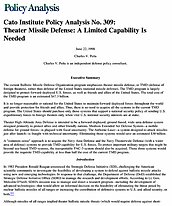The current Ballistic Missile Defense Organization program emphasizes theater missile defense, or TMD (defense of foreign theaters), rather than defense of the United States (national missile defense). The TMD program is largely designed to protect forward-deployed U.S. forces, as well as friends and allies of the United States. The total cost of the TMD program is an estimated $47.3 billion.
It is no longer reasonable or rational for the United States to maintain forward-deployed forces throughout the world and provide protection for friends and allies. Thus, there is no need to acquire all the systems in the current TMD program. The United States should purchase only those systems that support a national security policy of sending U.S. expeditionary forces to foreign theaters only when vital U.S. national security interests are at stake.
Theater High-Altitude Area Defense is intended to be a forward-deployed, ground-based, wide-area defense system designed primarily to protect allies and other friendly nations. Medium Extended Air Defense System–a mobile defense for ground forces–is plagued with fiscal uncertainty. The Airborne Laser–a system designed to attack missiles just after launch–is fraught with technical uncertainty. Eliminating those systems would save an estimated $30 billion.
A “common-sense” approach is to acquire the Navy Area Defense and the Navy Theaterwide Defense (with a wider area of defense) systems to provide TMD capability for U.S. forces. To protect important military targets that might be beyond sea-based TMD systems, the transportable PAC‑3 system should also be acquired. Those three systems would provide the requisite TMD capability at less than half the cost of the current TMD program.

This work is licensed under a Creative Commons Attribution-NonCommercial-ShareAlike 4.0 International License.

